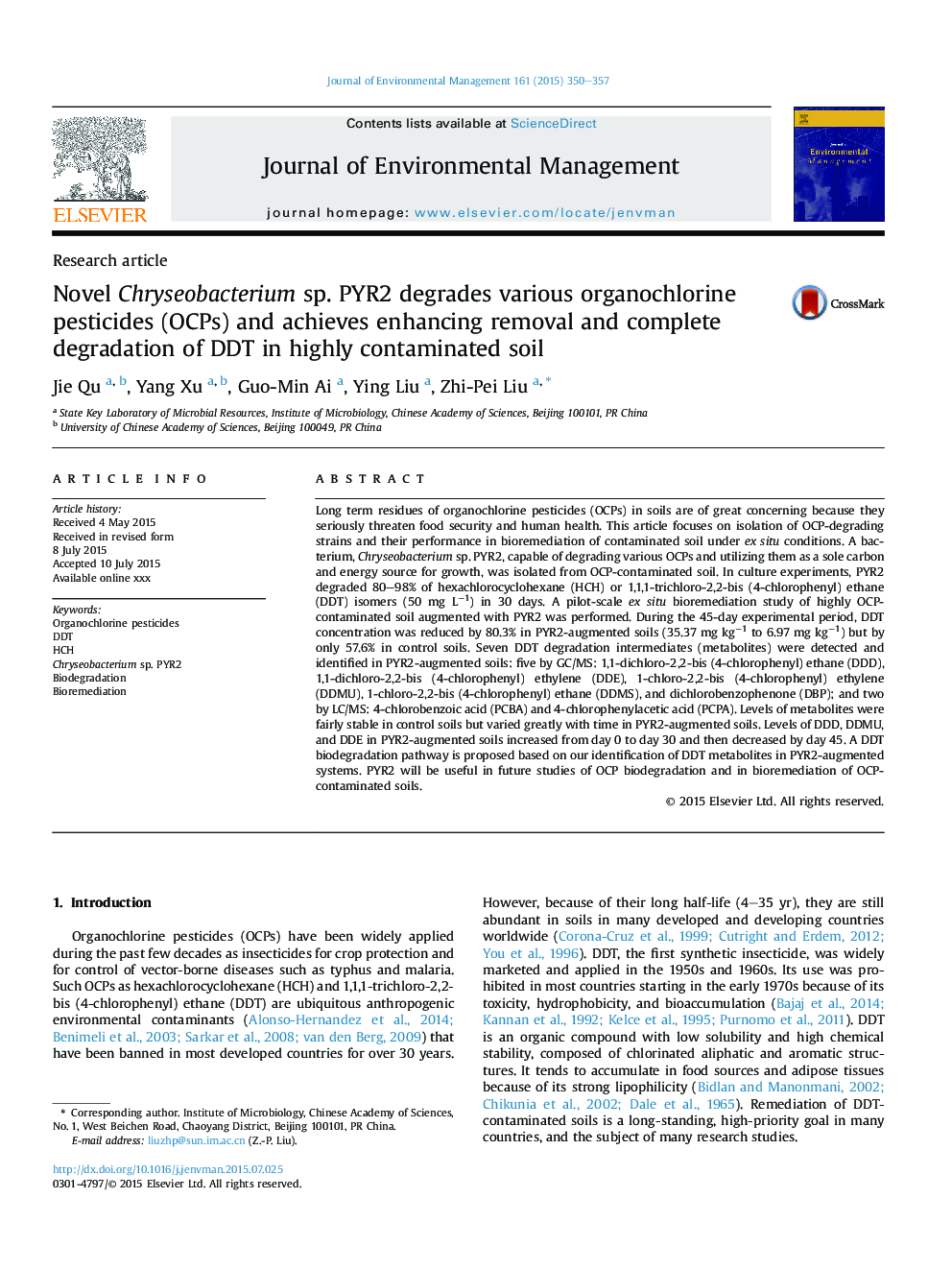| کد مقاله | کد نشریه | سال انتشار | مقاله انگلیسی | نسخه تمام متن |
|---|---|---|---|---|
| 7481869 | 1485251 | 2015 | 8 صفحه PDF | دانلود رایگان |
عنوان انگلیسی مقاله ISI
Novel Chryseobacterium sp. PYR2 degrades various organochlorine pesticides (OCPs) and achieves enhancing removal and complete degradation of DDT in highly contaminated soil
دانلود مقاله + سفارش ترجمه
دانلود مقاله ISI انگلیسی
رایگان برای ایرانیان
کلمات کلیدی
موضوعات مرتبط
مهندسی و علوم پایه
مهندسی انرژی
انرژی های تجدید پذیر، توسعه پایدار و محیط زیست
پیش نمایش صفحه اول مقاله

چکیده انگلیسی
Long term residues of organochlorine pesticides (OCPs) in soils are of great concerning because they seriously threaten food security and human health. This article focuses on isolation of OCP-degrading strains and their performance in bioremediation of contaminated soil under ex situ conditions. A bacterium, Chryseobacterium sp. PYR2, capable of degrading various OCPs and utilizing them as a sole carbon and energy source for growth, was isolated from OCP-contaminated soil. In culture experiments, PYR2 degraded 80-98% of hexachlorocyclohexane (HCH) or 1,1,1-trichloro-2,2-bis (4-chlorophenyl) ethane (DDT) isomers (50 mg Lâ1) in 30 days. A pilot-scale ex situ bioremediation study of highly OCP-contaminated soil augmented with PYR2 was performed. During the 45-day experimental period, DDT concentration was reduced by 80.3% in PYR2-augmented soils (35.37 mg kgâ1 to 6.97 mg kgâ1) but by only 57.6% in control soils. Seven DDT degradation intermediates (metabolites) were detected and identified in PYR2-augmented soils: five by GC/MS: 1,1-dichloro-2,2-bis (4-chlorophenyl) ethane (DDD), 1,1-dichloro-2,2-bis (4-chlorophenyl) ethylene (DDE), 1-chloro-2,2-bis (4-chlorophenyl) ethylene (DDMU), 1-chloro-2,2-bis (4-chlorophenyl) ethane (DDMS), and dichlorobenzophenone (DBP); and two by LC/MS: 4-chlorobenzoic acid (PCBA) and 4-chlorophenylacetic acid (PCPA). Levels of metabolites were fairly stable in control soils but varied greatly with time in PYR2-augmented soils. Levels of DDD, DDMU, and DDE in PYR2-augmented soils increased from day 0 to day 30 and then decreased by day 45. A DDT biodegradation pathway is proposed based on our identification of DDT metabolites in PYR2-augmented systems. PYR2 will be useful in future studies of OCP biodegradation and in bioremediation of OCP-contaminated soils.
ناشر
Database: Elsevier - ScienceDirect (ساینس دایرکت)
Journal: Journal of Environmental Management - Volume 161, 15 September 2015, Pages 350-357
Journal: Journal of Environmental Management - Volume 161, 15 September 2015, Pages 350-357
نویسندگان
Jie Qu, Yang Xu, Guo-Min Ai, Ying Liu, Zhi-Pei Liu,